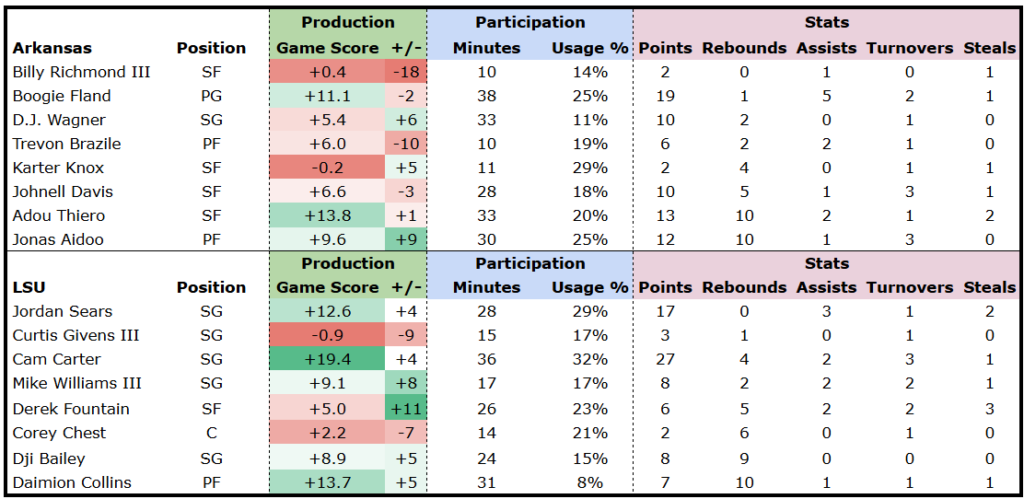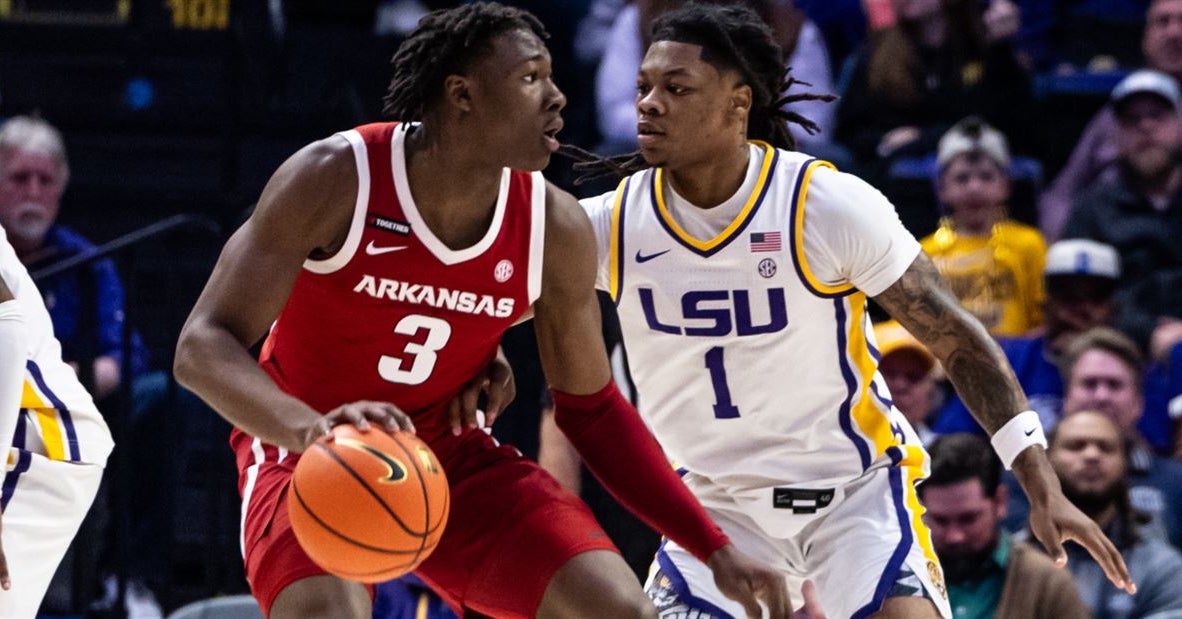It’s officially time to hit the panic button following Arkansas’ 78-74 loss to LSU in Baton Rouge. The Tigers aren’t bad, but they are certainly going to finish in the bottom half of the SEC standings, and the loss puts the Hogs at 0-4 in the SEC. They’ll need to finish 7-7 over their last 14 SEC games to even have a chance at reaching the NCAA Tournament, and 8-6 might be necessary to not sweat it out on Selection Sunday.
An old dog might need to (re-)learn a new trick
While the defense didn’t have a good second half against LSU, the offense has been a consistent issue this year. John Calipari chose not to bring assistant John Welch from Kentucky in a move that raised a lot of eyebrows. Welch was an NBA assistant from 2002 to 2020 and was credited with modernizing the Wildcat offense. Last year’s Kentucky team had excellent spacing and rained 3-pointers in an offense that finished top-5 in the nation in adjusted offensive efficiency.
In letting Welch walk, Cal made clear his preference for his 2010s Kentucky offenses. He even reunited with Kenny Payne, who was his top assistant during that era. But the game has changed. Arkansas’ ballscreen offense is stagnant, similar to where it was in the last couple years of the Eric Musselman era.
On the one hand, Cal will never run a pure college offense, whether it’s the Nate Oats “never attempt a midrange shot”, the Buzz Williams “watching us play will make you hate basketball”, or the Mike Anderson “press and try to run”. He wants to attract NBA talented players, so his scheme needs to prepare them for the league. But that’s what’s odd: what Arkansas is doing right now isn’t an NBA offense. Yes, like Arkansas and unlike Texas A&M, NBA teams don’t overemphasize trying to draw contact and get to the line. Yes, like Arkansas and unlike Alabama, NBA teams will punish drop coverage with pull-up jumpers. And yes, like Arkansas and unlike Kentucky, NBA teams favor guards who can create their own shot, rather than overly relying on being set up with spacing and ball movement.
But NBA teams shoot 3-pointers. And a lot of them! They design plays specifically to get a guy open for a 3-point look (and not just when they’re down 3 in the final seconds). They have guys who are actively looking to shoot from beyond the arc when they come into the game. NBA teams figured out years ago that shooting a lot of 3-pointers stretches the defense and creates open paths to the rim. As we saw in Musselman’s last couple years, not attempting many 3-pointers signals to the defense that you’re always looking to go inside, so defenders can cheat inside the arc and collapse on any ball movement.
As we’ll see in the stats below, Arkansas primarily lost this game because they couldn’t finish around the rim. That’s already been a major theme in SEC play and it will continue: athletic defenses can collapse inside on offenses that don’t space them out and threaten them with 3-pointers. Every SEC defense is capable of choking the Hogs around the rim.
So the biggest issue with this team isn’t fixable with this scheme or these players. Here’s hoping that Calipari is willing to relearn the tough lessons of the past few years. That probably involves adding an NBA assistant to his roster in the offseason, and placing more roster-building emphasis on 3-point specialists. Everyone raved about Johnell Davis’s 41% 3-point shooting last year, but Davis was not a “specialist” or primarily a catch-and-shoot guy. Less than a third of his field goal attempts were 3-pointers. He’s out of place, and Arkansas doesn’t have a catch-and-shoot guy, like an Isaiah Joe. And even if they did, they probably wouldn’t use him correctly this year. If you could pair Joe (or, say, Jaxson Robinson) with a point guard like Boogie Fland, you’d have a powerful offense. That’s what the Hogs need to do to build around Darius Acuff and Maleek Thomas for next year. If they don’t, Acuff and Thomas are going to end up taking a ton of contested shots.
Advanced stats

There are problems all over this chart. Defensively, the Hogs allowed LSU’s 79th-ranked offense to post a 109.9 efficiency, including 115.8 in the second half. We’ll look at how that happened in a second, but the Tigers scoring on 51% of their total possessions and half of their halfcourt possessions is a big reason why.
Offensively, the Hogs just aren’t good. They won the battle in transition 27-22, but they finished with a weak 88.7 halfcourt efficiency and took way too long on offense, needing 17.8 seconds per offensive possession. Teams with athletic advantages like Arkansas need to go fast in order to take full advantage, but the Hogs lack the offensive scheme and spacing to actually play with pace.

Arkansas’ 71 possessions became 74 shot chances (69 field goals and five trips to the line). LSU’s 71 possessions become 66 shot chances (55 field goals and 11 trips to the line). Despite that +8 advantage in extra scoring chances (+5 offensive rebounds and +3 turnovers), the Hogs shot much worse.
Several things caused this. LSU finished around the rim much better, as the Hogs shot only 41% on layups, dunks, and tip-ins, which is awful. And LSU got to the line much more, attempting 28 free throws to Arkansas’ 13. Arkansas won points in the paint (34-28) and made more 3-pointers (9-8). How many teams could win both of those stats, plus offensive rebounds and turnovers, and still lose?
One of the biggest changes from the Eric Musselman scheme is free throws. Muss’s teams always lived at the line, allowing them to overcome bad shooting nights. Calipari’s don’t. The Hogs now rank 253rd out of 364 teams in free throw attempt rate. Pair that with not attempting a lot of 3-pointers, and you have the recipe for an offense that has to work really hard to score.

When you have a nine-man roster, you can’t really afford two no-shows, but the Hogs saw Billy Richmond III and Trevon Brazile have awful nights, and that sealed the deal. The Razorbacks were plus-9 with Jonas Aidoo on the floor, but Brazile was minus-10 and Richmond minus-18.
